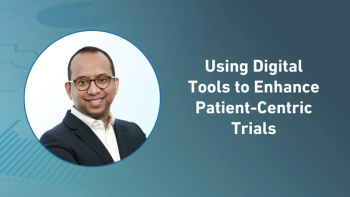
- Applied Clinical Trials-02-01-2024
- Volume 33
- Issue 1/2
The Future of AI in Clinical Trials: Q&A With Seema Verma, GM and SVP, Oracle Life Sciences
Verma discusses the use of technology and data to increase clinical trial access.
As the calendar transitions to 2024, artificial intelligence (AI) is sure to continue trending in the clinical trials industry. In this Q&A, Seema Verma, GM and SVP, Oracle Life Sciences, discusses what AI’s impact will be as well as utilizing technology and multiple data sources to advance trial execution.
Applied Clinical Trials: What impact will AI have on the clinical trials industry in the next few years?
Seema Verma: AI, machine learning, and related technologies have the potential to transform the entire drug development life cycle. For example, AI is helping discover novel molecular structures and designs, forecast drug-target interactions, and accelerate in-silico drug discovery. These improvements can significantly reduce the time and cost of bringing new treatments to market.
These advanced applications of AI are generating headlines and a great deal of excitement. In the next few years, we could see advancements in interoperability and data sharing, a greater focus on patient centricity, and an uptick in telehealth and remote monitoring.
As an industry, we have to get to a point where it becomes easier for providers to participate at the point of care; AI can help make significant progress towards reducing the burden on providers. Currently, providers have to search for clinical trials for their patients, but through greater interoperability of and access to data, they could obtain the information they need at the point of care. Oracle is uniquely positioned to address this because we have the full spectrum from clinical trial software to the electronic medical record.
We should also see AI impact in the less glamorous but critical business of automating cumbersome, manual, and costly processes that still sit at the heart of the life sciences industry. This automation can alleviate many of the manual tasks that exist today, such as staff having to move data from the electronic health record (EHR) to the electronic data capture, therefore enabling them to focus on other important tasks.
AI will also continue to play an important role in analyzing real-world evidence, which is crucial in risk assessment and understanding the effectiveness and safety of treatments in clinical settings, but it could also apply to clinical trial design.
ACT: How can industry better connect clinical trials and clinical care?
Verma: The Achilles heel of clinical trials has been access and awareness, but technology is helping to change that. Patient matching is enabled by advanced algorithms and data analytics based on medical records. There is also potential to use data from other sources such as the EHR, lab results, imaging, etc. to connect patients to trials. For example, based on a patient’s genetic sequencing and the type of cancer they have, we could identify a specific trial for the patient. With technology and the ability to use matching within the clinical workflow, we can connect patient care and trials seamlessly.
Currently, clinical research is based on small snippets of health data, while many important elements of patient clinical care data sit inaccessible and siloed. However, we are at a tipping point where technology is helping us get closer to the goal of making clinical research an accessible care option for anyone, from anywhere. Cloud technology is helping to bridge the gap toward greater access to connected, robust data sets. For example, through our Learning Health Network, a nationwide network of health systems ranging from small clinics to large hospitals, facilities can share de-identified EHR data. This means physicians and clinical researchers have access to more complete data sets that can provide actionable knowledge and insights.
Meanwhile, automation can help ease—and even speed up the processes involved in clinical trials—from patient recruitment and enrollment to monitoring and reporting—making it easier for patients to participate. Many of these tasks are done remotely, as we saw during the pandemic when telehealth and remote monitoring exploded. By putting the patient first and aligning decisions with their needs and preferences, we can make it easier for them to participate in trials.
Another important connection between clinical care and clinical trials is that trials should not end with drug approval. We want to be able to follow patients over the long term to learn and make discoveries. The ability to have access to multiple sources of real-world data (RWD) is critical from the point of care to trials and beyond.
ACT: How can technology help sponsors expand access to and increase diversity in clinical trials?
Verma: Automated, cloud-based technology, including remote enrollment tools, e-consent forms, wearables, and remote devices and data capture, can help create a more flexible clinical trial model by reducing the importance of physical location. This eases the patient burden and makes it easier to build a diverse pool of clinical trial candidates from nearly anywhere.
Cloud-based solutions also enable two-way communication channels for patients, doctors, and trial administrators to talk and share data, essentially in real-time. For example, remote monitoring enables doctors and trial administrators to access and analyze contemporaneous patient data even if patients are thousands of miles away. If there’s a problem, they can act quickly, assist the patient remotely, and alert the nearest medical facility as needed.
The US Centers for Disease Control and Prevention (CDC) deployed at scale an early example of these capabilities when they launched the
These platforms also offer doctors a more comprehensive record of patient care by connecting external and internal patient data through the cloud. The result is a holistic view, with cleansed, up-to-date insight into a patient’s health history through discrete data, such as lab results, vital signs, and encounters, in near real-time. Data that may have taken months to collect can now be accessed in seconds. With such precise data and analysis, providers can provide increasingly personalized care plans for their patients.
ACT: How important is having access to multiple sources of data (e.g. clinical, real-world, or genetic) as industry moves forward?
Verma: Clinical research combined with RWD provides deeper insights into the natural history of diseases and the performance of healthcare interventions in medical settings. These RWD sources will become pivotal in enhancing clinical trial execution, generating drug safety and efficacy evidence, and drug reimbursement strategies.
While it can be difficult for trial administrators and doctors to manage multiple sources of data, technology can address this challenge by aggregating data from any source for data processing activities, such as data review and cleansing, reconciliation, discrepancy management, and provisioning it in various formats to support analysis and reporting. In 2024 we expect to continue to see technologies such as Generative AI summarize key elements of patients’ records to help care and trial providers quickly get to the facts and information they need without having to scan pages of data. To make this a reality, eClinical providers should be focused on developing systems that amalgamate the use of these technologies and methods into ecosystems that provide a holistic 360-degree view of the patient, site performance, and overall view of the study.
Ultimately, with streamlined access to trial and patient data we could see an accelerated clinical trial process, faster time to market, overall cost savings, and most importantly, more positive outcomes.
Articles in this issue
almost 2 years ago
The Winds of Changealmost 2 years ago
The CRA of the Future: From ‘Road Warrior’ to Site ‘Owner’almost 2 years ago
‘Upskilling’ Your Workforce to Keep Pace with Changealmost 2 years ago
eCOA Flexibility in Clinical Trials: The Site Perspectivealmost 2 years ago
15 ‘Shades’ of Change in Clinical Trial Start-Up and ExecutionNewsletter
Stay current in clinical research with Applied Clinical Trials, providing expert insights, regulatory updates, and practical strategies for successful clinical trial design and execution.




